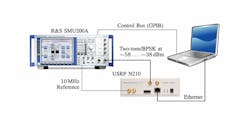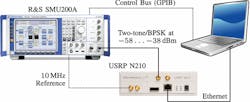Mitigate Distortions in Software-Defined Wideband Receivers
Software-defined-radio (SDR) technologies are becoming more viable for radio systems ranging from military to mobile wireless. As the use of these radio systems grows, techniques for managing the performance of these deployments will be needed. Maintaining a reasonable spurious-free dynamic range (SFDR) and adequate linearity can be challenging for SDR deployments, which rely on flexible spectrum use to optimize radio-system performance. To enhance these radios’ performance in multi-carrier/multi-radio environments, the analysis and digital mitigation of nonlinear distortions with SDRs has been researched by Michael Grimm and Reiner Thoma from the Ilmenau University of Technology, Ilmenau, Germany, and Markus Allen, Jaakko Marttila, and Mikko Valkama from the Tampere University of Technology in Tampere, Finland.
Their paper focuses on the use of digital feed-forward mitigation algorithms. These are used to clean the broadband signal of nonlinear distortions and mirror-frequency interferers with wideband multi-carrier/multi-radio direct-conversion receivers (DCRs). The architecture consists of a parallel, adaptive digital-mitigation structure for cascaded RF and broadband nonlinearities with mixer and broadband in-phase/quadrature (I/Q) imbalances. A two-tone signal generator and USRP SDR with a computer interface are used to experimentally verify the proposed mitigation architecture.
The researchers provide rigorous mathematical, simulation, and experimental explanations to describe and justify the technique. The results of the experimentation confirmed the enhanced performance for both the linearity and SFDR of an SDR. Thus, some proof of the existence of nonlinear distortions in these environments was provided. The paper mentions that the technique may also be applied to DCRs as a whole and not strictly DCR SDRs.
See “Joint Mitigation of Nonlinear RF and Baseband Distortions in Wideband Direct-Conversion Receivers,” IEEE Transactions On Microwave Theory And Techniques, Jan. 2014, p. 166-182.
About the Author
Jean-Jacques DeLisle
Jean-Jacques graduated from the Rochester Institute of Technology, where he completed his Master of Science in Electrical Engineering. In his studies, Jean-Jacques focused on Control Systems Design, Mixed-Signal IC Design, and RF Design. His research focus was in smart-sensor platform design for RF connector applications for the telecommunications industry. During his research, Jean-Jacques developed a passion for the field of RF/microwaves and expanded his knowledge by doing R&D for the telecommunications industry.

